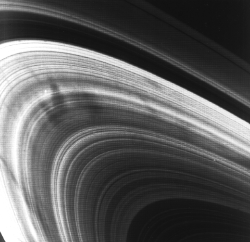Space Dust in a Vacuum

The solar system is a dusty place. Astrophysicists see dust on the moon, on asteroids, and in the rings of planets. The particles can become electrically charged, which leads to surprising phenomena, such as the layer of levitated dust the astronauts saw on the Moon. The Sun’s ultraviolet (UV) photons should charge up dust grains by knocking off electrons, but this theory has not been proven in the lab. By dropping dust grains through an evacuated chamber under UV illumination, a team has confirmed that dust is charged by the photoelectric effect, as they report in the 26 June PRL. Their paper, which relies mainly on ideas from freshman level physics, firms up the theory behind the electrically driven motion of dust around planets, moons, and even spacecraft.
NASA first saw the levitated Moon dust with unmanned spacecraft in the 1960s, and astronauts later observed a glow from dust suspended above the lunar horizon at sunset. “You wouldn’t think dust moves around, because there’s no air,” says Scott Robertson of the University of Colorado at Boulder, and researchers have assumed that the dust levitation comes from the photoelectric effect: UV photons eject electrons from the surface of an isolated grain, giving it a positive charge. At the same time, the photons constantly knock electrons off the Moon’s surface rocks and create a continuous upward spray of electrons. So dust grains near the surface are hit by more electrons than photons, and they become negatively charged. At about a meter above the surface, where photoelectrons are less plentiful, the positively charged dust grains float, repelled by the positively-charged Moon.
That’s the theory. To prove that dust can become positively or negatively charged by these schemes, Robertson and his colleagues designed a simple experiment. They allowed individual 100 µm diameter particles of zinc, copper, and graphite to drop about 30 cm through an evacuated chamber, illuminated by UV light from a powerful arc lamp. The dust dropping mechanism was a small holder with a vibrating bottom plate containing a single hole. “It’s very similar to a salt shaker,” says Robertson. The grains dropped into a Faraday cup, which allows a direct measurement of their charge. In a second set of experiments, the team added a zirconium plate behind but close to the path of the dropping dust grains to simulate the effect of a nearby surface (such as moon rocks) that emits many photoelectrons.
Without the plate, the isolated dust particles acquired approximately the charges the researchers expected, based on their photoelectric properties: All were positive, near 40,000 electron charges. With the zirconium plate in place as a source of photoelectrons, the dust became negatively charged by about the same amount.
Robert Merlino of the University of Iowa in Iowa City says he was surprised that the electrons ejected from a nearby surface could overwhelm the photons hitting a dust grain and give it a negative charge. “I would not have expected that the photoelectrons from the surface could have made that much of a difference,” he says. “This is the sort of thing that you learn by doing experiments.” Robertson adds that an understanding of dust charging is important for modeling the small-scale environments of spacecraft (including exhaust “dust”) as well as the large-scale effects of the coalescence of dust in the forming of a solar system.


